Page 888 of 2543
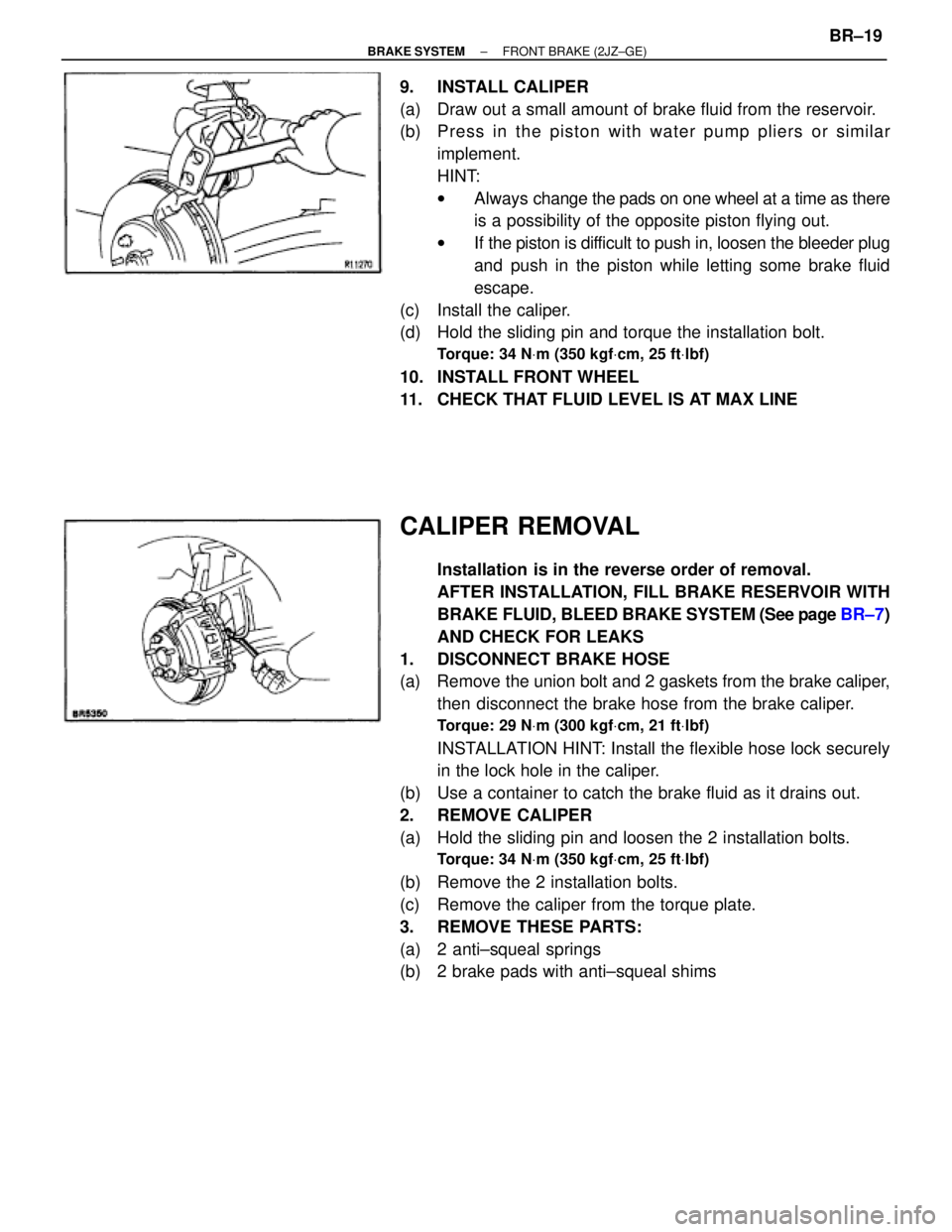
9. INSTALL CALIPER
(a) Draw out a small amount of brake fluid from the reservoir.
(b) P re ss in th e pisto n with wa te r pu mp plie rs or simila r
implement.
HINT:
wAlways change the pads on one wheel at a time as there
is a possibility of the opposite piston flying out.
wIf the piston is difficult to push in, loosen the bleeder plug
and push in the piston while letting some brake fluid
escape.
(c) Install the caliper.
(d) Hold the sliding pin and torque the installation bolt.
Torque: 34 NVm (350 kgfVcm, 25 ftVlbf)
10. INSTALL FRONT WHEEL
11. CHECK THAT FLUID LEVEL IS AT MAX LINE
CALIPER REMOVAL
Installation is in the reverse order of removal.
AFTER INSTALLATION, FILL BRAKE RESERVOIR WITH
BRAKE FLUID, BLEED BRAKE SYSTEM (See page BR±7)
AND CHECK FOR LEAKS
1. DISCONNECT BRAKE HOSE
(a) Remove the union bolt and 2 gaskets from the brake caliper,
then disconnect the brake hose from the brake caliper.
Torque: 29 NVm (300 kgfVcm, 21 ftVlbf)
INSTALLATION HINT: Install the flexible hose lock securely
in the lock hole in the caliper.
(b) Use a container to catch the brake fluid as it drains out.
2. REMOVE CALIPER
(a) Hold the sliding pin and loosen the 2 installation bolts.
Torque: 34 NVm (350 kgfVcm, 25 ftVlbf)
(b) Remove the 2 installation bolts.
(c) Remove the caliper from the torque plate.
3. REMOVE THESE PARTS:
(a) 2 anti±squeal springs
(b) 2 brake pads with anti±squeal shims
± BRAKE SYSTEMFRONT BRAKE (2JZ±GE)BR±19
Page 892 of 2543
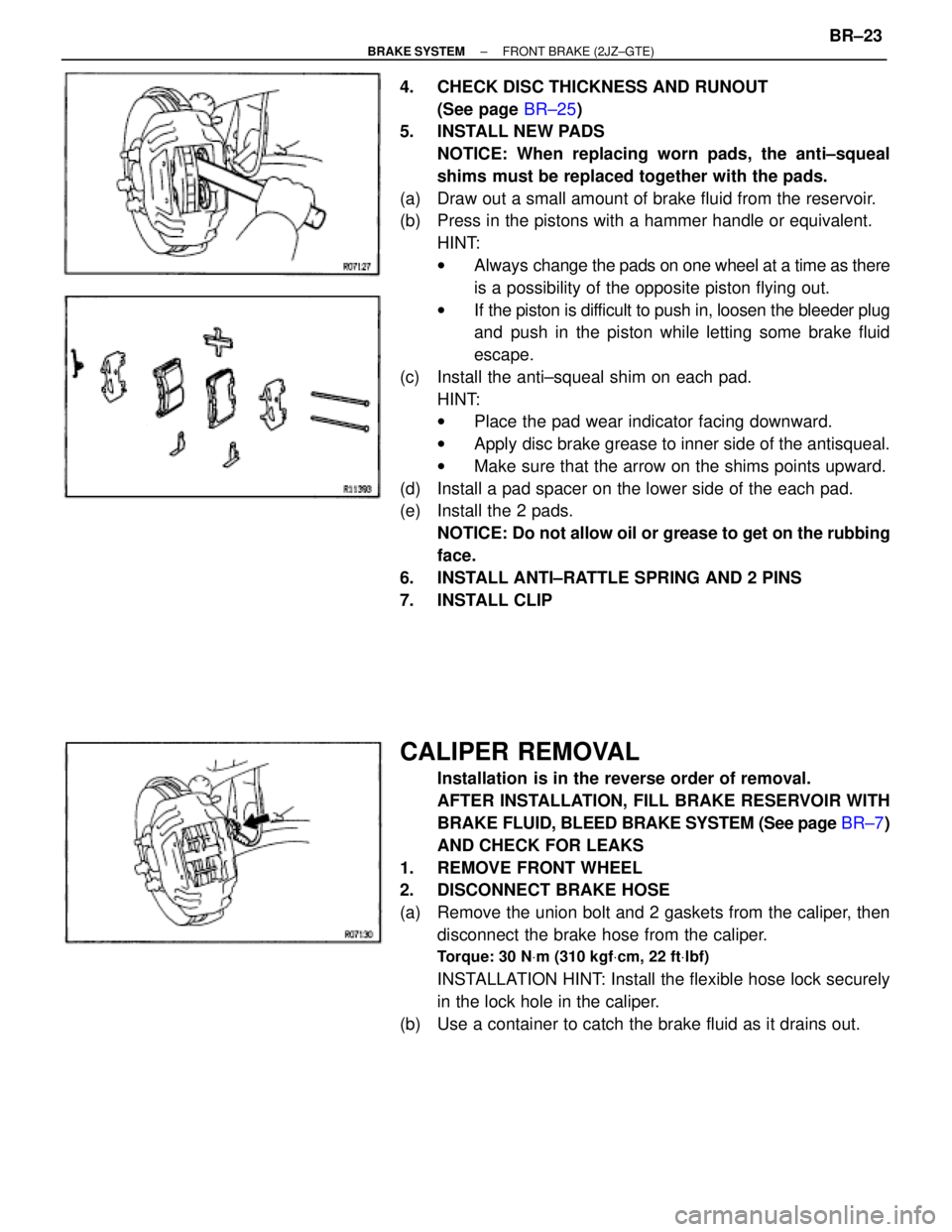
4. CHECK DISC THICKNESS AND RUNOUT
(See page BR±25)
5. INSTALL NEW PADS
NOTICE: When replacing worn pads, the anti±squeal
shims must be replaced together with the pads.
(a) Draw out a small amount of brake fluid from the reservoir.
(b) Press in the pistons with a hammer handle or equivalent.
HINT:
wAlways change the pads on one wheel at a time as there
is a possibility of the opposite piston flying out.
wIf the piston is difficult to push in, loosen the bleeder plug
and push in the piston while letting some brake fluid
escape.
(c) Install the anti±squeal shim on each pad.
HINT:
wPlace the pad wear indicator facing downward.
wApply disc brake grease to inner side of the antisqueal.
wMake sure that the arrow on the shims points upward.
(d) Install a pad spacer on the lower side of the each pad.
(e) Install the 2 pads.
NOTICE: Do not allow oil or grease to get on the rubbing
face.
6. INSTALL ANTI±RATTLE SPRING AND 2 PINS
7. INSTALL CLIP
CALIPER REMOVAL
Installation is in the reverse order of removal.
AFTER INSTALLATION, FILL BRAKE RESERVOIR WITH
BRAKE FLUID, BLEED BRAKE SYSTEM (See page BR±7)
AND CHECK FOR LEAKS
1. REMOVE FRONT WHEEL
2. DISCONNECT BRAKE HOSE
(a) Remove the union bolt and 2 gaskets from the caliper, then
disconnect the brake hose from the caliper.
Torque: 30 NVm (310 kgfVcm, 22 ftVlbf)
INSTALLATION HINT: Install the flexible hose lock securely
in the lock hole in the caliper.
(b) Use a container to catch the brake fluid as it drains out.
± BRAKE SYSTEMFRONT BRAKE (2JZ±GTE)BR±23
Page 894 of 2543
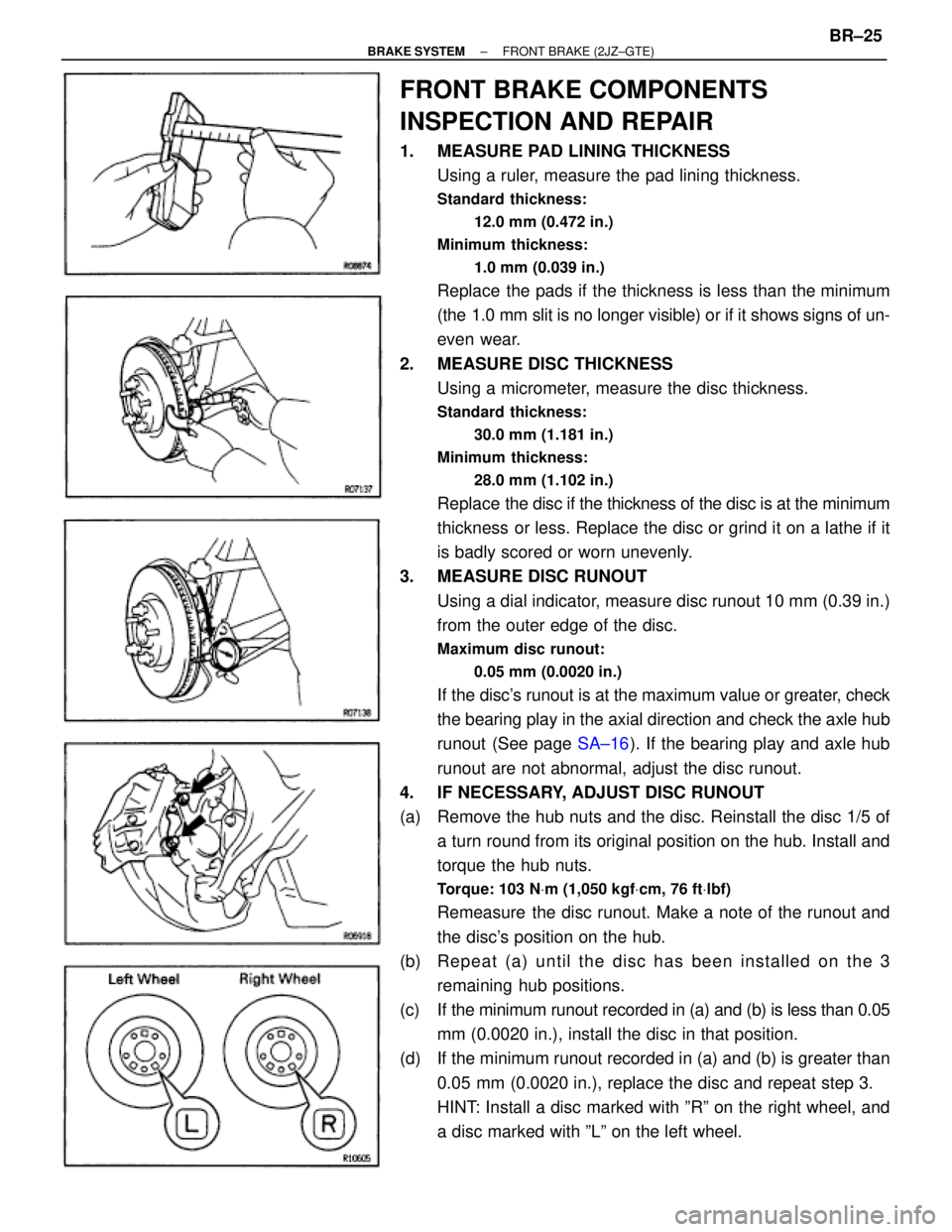
FRONT BRAKE COMPONENTS
INSPECTION AND REPAIR
1. MEASURE PAD LINING THICKNESS
Using a ruler, measure the pad lining thickness.
Standard thickness:
12.0 mm (0.472 in.)
Minimum thickness:
1.0 mm (0.039 in.)
Replace the pads if the thickness is less than the minimum
(the 1.0 mm slit is no longer visible) or if it shows signs of un-
even wear.
2. MEASURE DISC THICKNESS
Using a micrometer, measure the disc thickness.
Standard thickness:
30.0 mm (1.181 in.)
Minimum thickness:
28.0 mm (1.102 in.)
Replace the disc if the thickness of the disc is at the minimum
thickness or less. Replace the disc or grind it on a lathe if it
is badly scored or worn unevenly.
3. MEASURE DISC RUNOUT
Using a dial indicator, measure disc runout 10 mm (0.39 in.)
from the outer edge of the disc.
Maximum disc runout:
0.05 mm (0.0020 in.)
If the disc's runout is at the maximum value or greater, check
the bearing play in the axial direction and check the axle hub
runout (See page SA±16). If the bearing play and axle hub
runout are not abnormal, adjust the disc runout.
4. IF NECESSARY, ADJUST DISC RUNOUT
(a) Remove the hub nuts and the disc. Reinstall the disc 1/5 of
a turn round from its original position on the hub. Install and
torque the hub nuts.
Torque: 103 NVm (1,050 kgfVcm, 76 ftVlbf)
Remeasure the disc runout. Make a note of the runout and
the disc's position on the hub.
(b) Repeat (a) until the disc has been installed on the 3
remaining hub positions.
(c) If the minimum runout recorded in (a) and (b) is less than 0.05
mm (0.0020 in.), install the disc in that position.
(d) If the minimum runout recorded in (a) and (b) is greater than
0.05 mm (0.0020 in.), replace the disc and repeat step 3.
HINT: Install a disc marked with ºRº on the right wheel, and
a disc marked with ºLº on the left wheel.
± BRAKE SYSTEMFRONT BRAKE (2JZ±GTE)BR±25
Page 897 of 2543
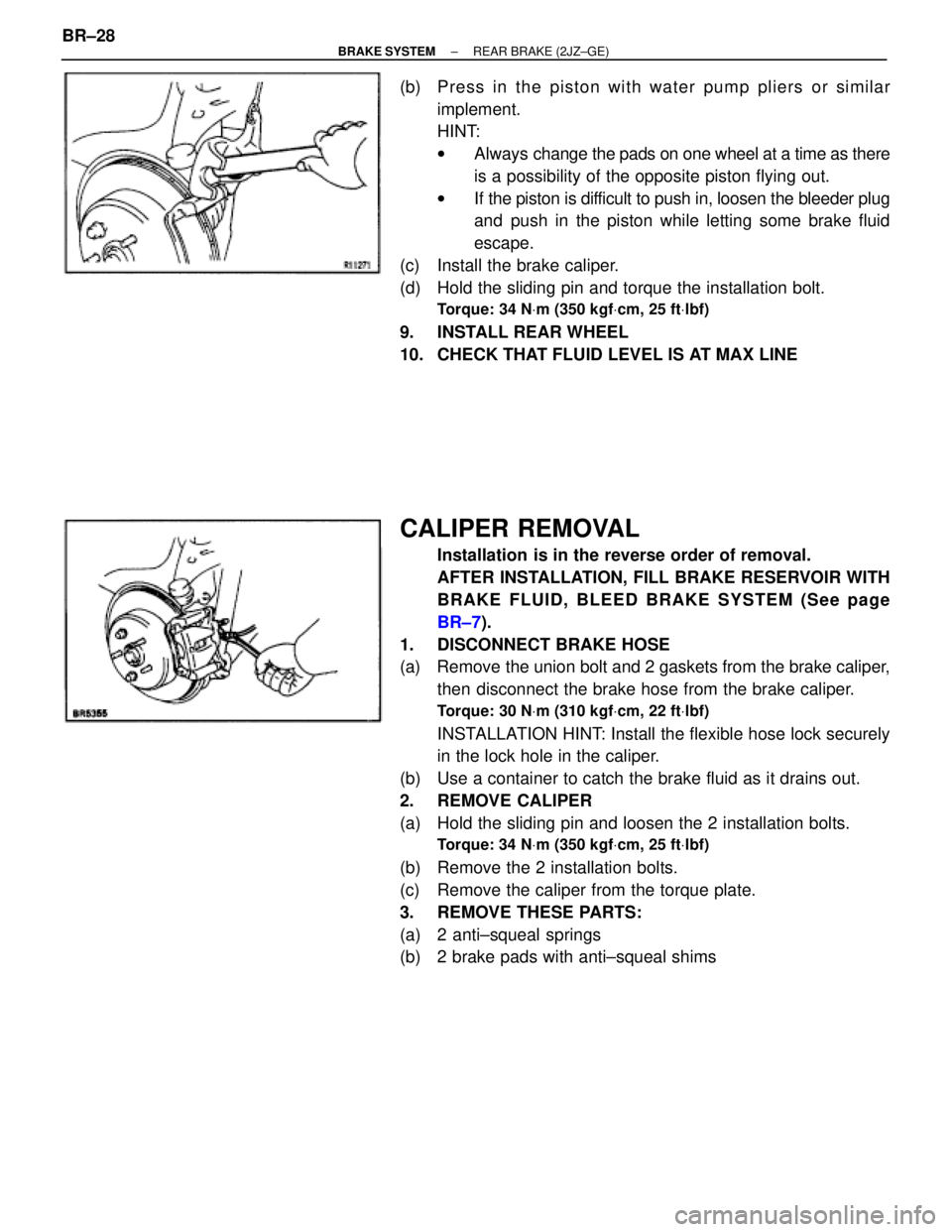
(b) Press in the piston with water pump pliers or similar
implement.
HINT:
wAlways change the pads on one wheel at a time as there
is a possibility of the opposite piston flying out.
wIf the piston is difficult to push in, loosen the bleeder plug
and push in the piston while letting some brake fluid
escape.
(c) Install the brake caliper.
(d) Hold the sliding pin and torque the installation bolt.
Torque: 34 NVm (350 kgfVcm, 25 ftVlbf)
9. INSTALL REAR WHEEL
10. CHECK THAT FLUID LEVEL IS AT MAX LINE
CALIPER REMOVAL
Installation is in the reverse order of removal.
AFTER INSTALLATION, FILL BRAKE RESERVOIR WITH
BRAKE FLUID, BLEED BRAKE SYSTEM (See page
BR±7).
1. DISCONNECT BRAKE HOSE
(a) Remove the union bolt and 2 gaskets from the brake caliper,
then disconnect the brake hose from the brake caliper.
Torque: 30 NVm (310 kgfVcm, 22 ftVlbf)
INSTALLATION HINT: Install the flexible hose lock securely
in the lock hole in the caliper.
(b) Use a container to catch the brake fluid as it drains out.
2. REMOVE CALIPER
(a) Hold the sliding pin and loosen the 2 installation bolts.
Torque: 34 NVm (350 kgfVcm, 25 ftVlbf)
(b) Remove the 2 installation bolts.
(c) Remove the caliper from the torque plate.
3. REMOVE THESE PARTS:
(a) 2 anti±squeal springs
(b) 2 brake pads with anti±squeal shims BR±28
± BRAKE SYSTEMREAR BRAKE (2JZ±GE)
Page 901 of 2543
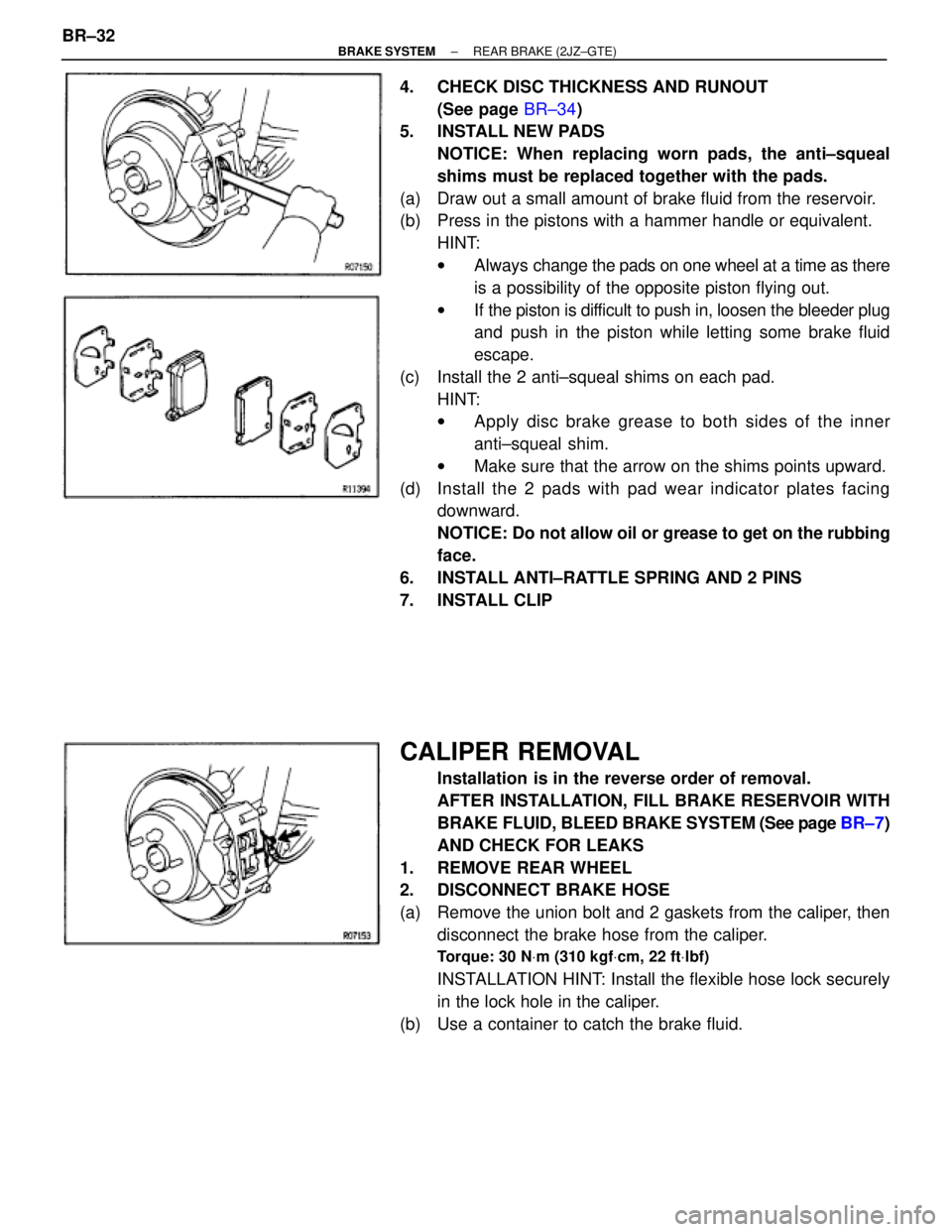
4. CHECK DISC THICKNESS AND RUNOUT
(See page BR±34)
5. INSTALL NEW PADS
NOTICE: When replacing worn pads, the anti±squeal
shims must be replaced together with the pads.
(a) Draw out a small amount of brake fluid from the reservoir.
(b) Press in the pistons with a hammer handle or equivalent.
HINT:
wAlways change the pads on one wheel at a time as there
is a possibility of the opposite piston flying out.
wIf the piston is difficult to push in, loosen the bleeder plug
and push in the piston while letting some brake fluid
escape.
(c) Install the 2 anti±squeal shims on each pad.
HINT:
wApply disc brake grease to both sides of the inner
anti±squeal shim.
wMake sure that the arrow on the shims points upward.
(d) Install the 2 pads with pad wear indicator plates facing
downward.
NOTICE: Do not allow oil or grease to get on the rubbing
face.
6. INSTALL ANTI±RATTLE SPRING AND 2 PINS
7. INSTALL CLIP
CALIPER REMOVAL
Installation is in the reverse order of removal.
AFTER INSTALLATION, FILL BRAKE RESERVOIR WITH
BRAKE FLUID, BLEED BRAKE SYSTEM (See page BR±7)
AND CHECK FOR LEAKS
1. REMOVE REAR WHEEL
2. DISCONNECT BRAKE HOSE
(a) Remove the union bolt and 2 gaskets from the caliper, then
disconnect the brake hose from the caliper.
Torque: 30 NVm (310 kgfVcm, 22 ftVlbf)
INSTALLATION HINT: Install the flexible hose lock securely
in the lock hole in the caliper.
(b) Use a container to catch the brake fluid. BR±32
± BRAKE SYSTEMREAR BRAKE (2JZ±GTE)
Page 908 of 2543
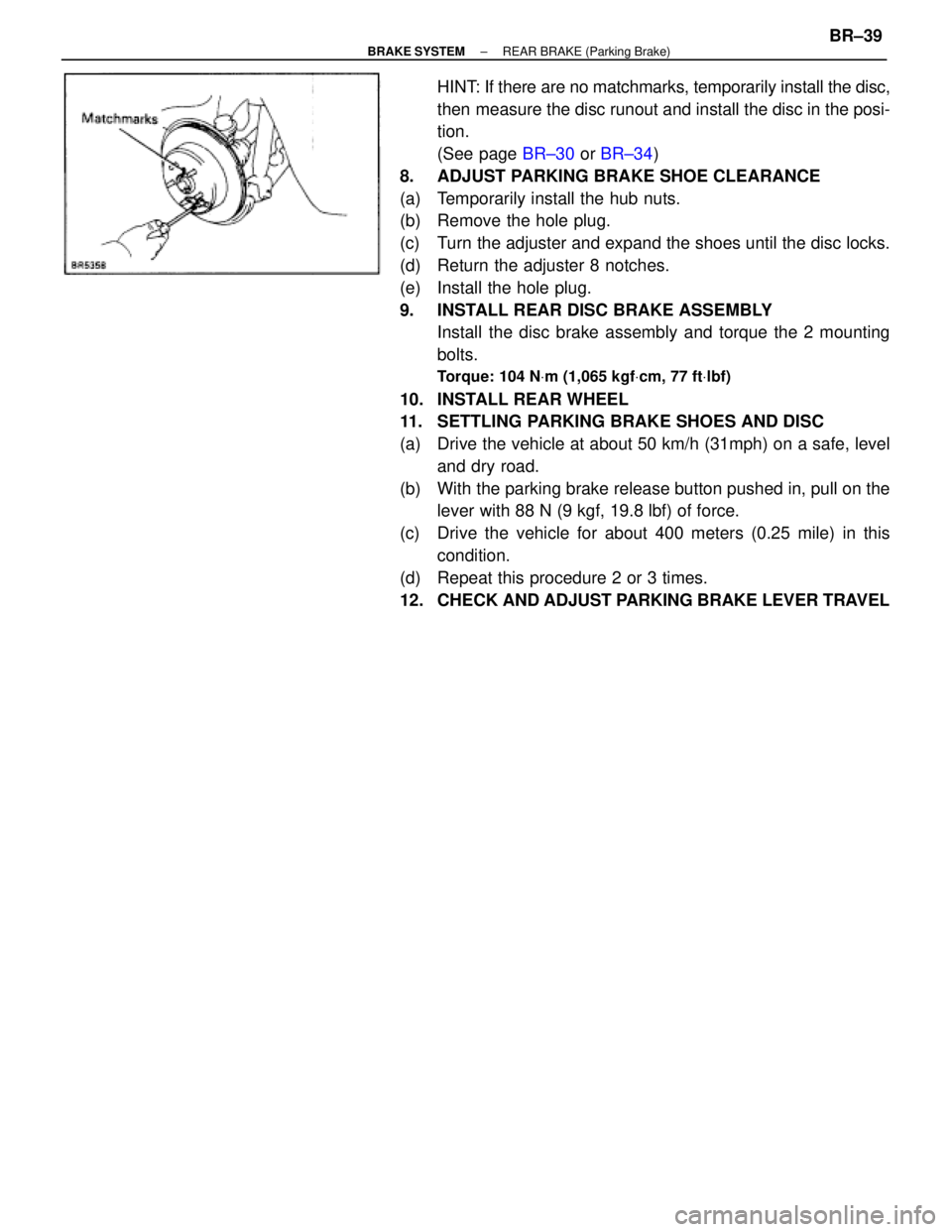
HINT: If there are no matchmarks, temporarily install the disc,
then measure the disc runout and install the disc in the posi-
tion.
(See page BR±30 or BR±34)
8. ADJUST PARKING BRAKE SHOE CLEARANCE
(a) Temporarily install the hub nuts.
(b) Remove the hole plug.
(c) Turn the adjuster and expand the shoes until the disc locks.
(d) Return the adjuster 8 notches.
(e) Install the hole plug.
9. INSTALL REAR DISC BRAKE ASSEMBLY
Install the disc brake assembly and torque the 2 mounting
bolts.
Torque: 104 NVm (1,065 kgfVcm, 77 ftVlbf)
10. INSTALL REAR WHEEL
11. SETTLING PARKING BRAKE SHOES AND DISC
(a) Drive the vehicle at about 50 km/h (31mph) on a safe, level
and dry road.
(b) With the parking brake release button pushed in, pull on the
lever with 88 N (9 kgf, 19.8 lbf) of force.
(c) Drive the vehicle for about 400 meters (0.25 mile) in this
condition.
(d) Repeat this procedure 2 or 3 times.
12. CHECK AND ADJUST PARKING BRAKE LEVER TRAVEL
± BRAKE SYSTEMREAR BRAKE (Parking Brake)BR±39
Page 1072 of 2543
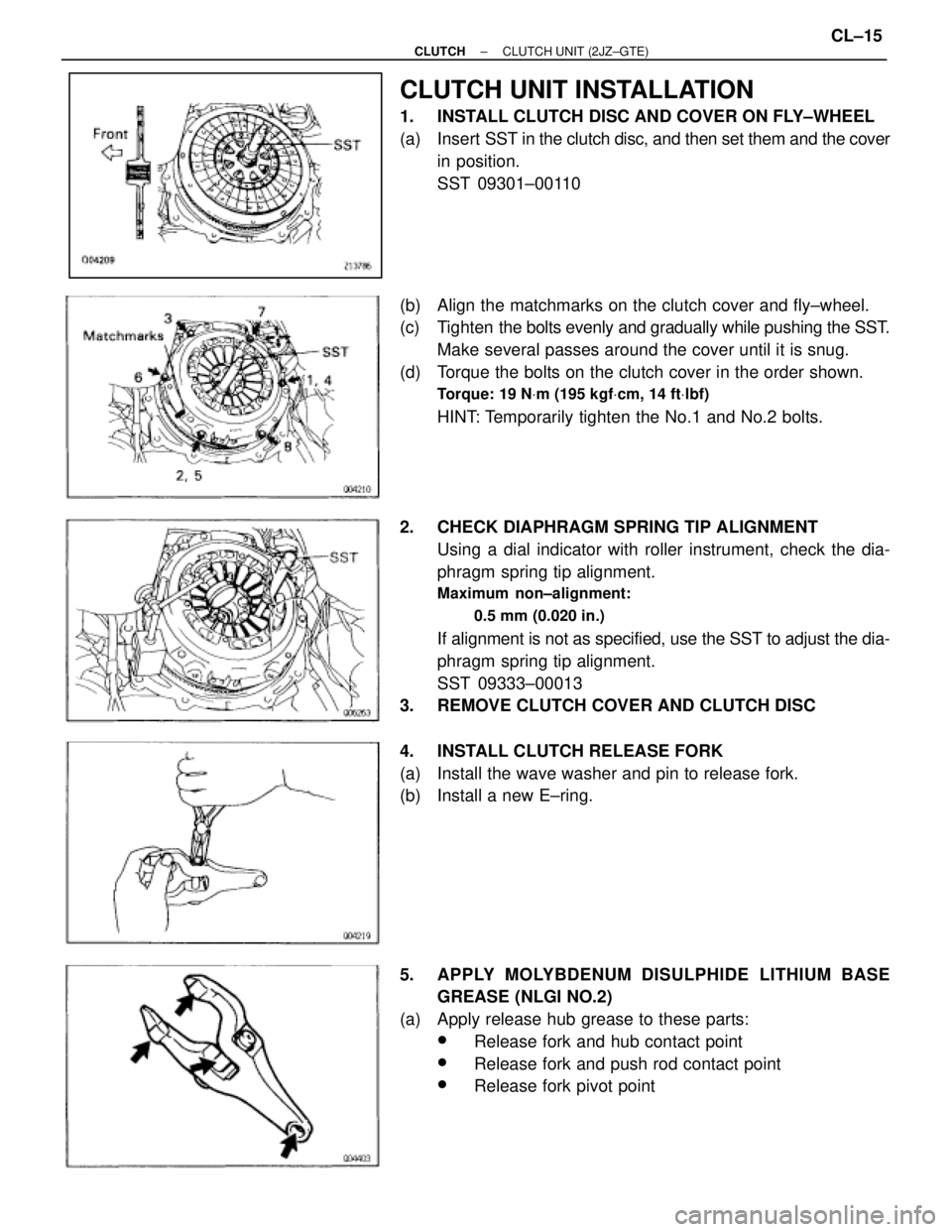
CLUTCH UNIT INSTALLATION
1. INSTALL CLUTCH DISC AND COVER ON FLY±WHEEL
(a) Insert SST in the clutch disc, and then set them and the cover
in position.
SST 09301±00110
(b) Align the matchmarks on the clutch cover and fly±wheel.
(c) Tighten the bolts evenly and gradually while pushing the SST.
Make several passes around the cover until it is snug.
(d) Torque the bolts on the clutch cover in the order shown.
Torque: 19 NVm (195 kgfVcm, 14 ftVlbf)
HINT: Temporarily tighten the No.1 and No.2 bolts.
2. CHECK DIAPHRAGM SPRING TIP ALIGNMENT
Using a dial indicator with roller instrument, check the dia-
phragm spring tip alignment.
Maximum non±alignment:
0.5 mm (0.020 in.)
If alignment is not as specified, use the SST to adjust the dia-
phragm spring tip alignment.
SST 09333±00013
3. REMOVE CLUTCH COVER AND CLUTCH DISC
4. INSTALL CLUTCH RELEASE FORK
(a) Install the wave washer and pin to release fork.
(b) Install a new E±ring.
5. APPLY MOLYBDENUM DISULPHIDE LITHIUM BASE
GREASE (NLGI NO.2)
(a) Apply release hub grease to these parts:
wRelease fork and hub contact point
wRelease fork and push rod contact point
wRelease fork pivot point
± CLUTCHCLUTCH UNIT (2JZ±GTE)CL±15
Page 1077 of 2543
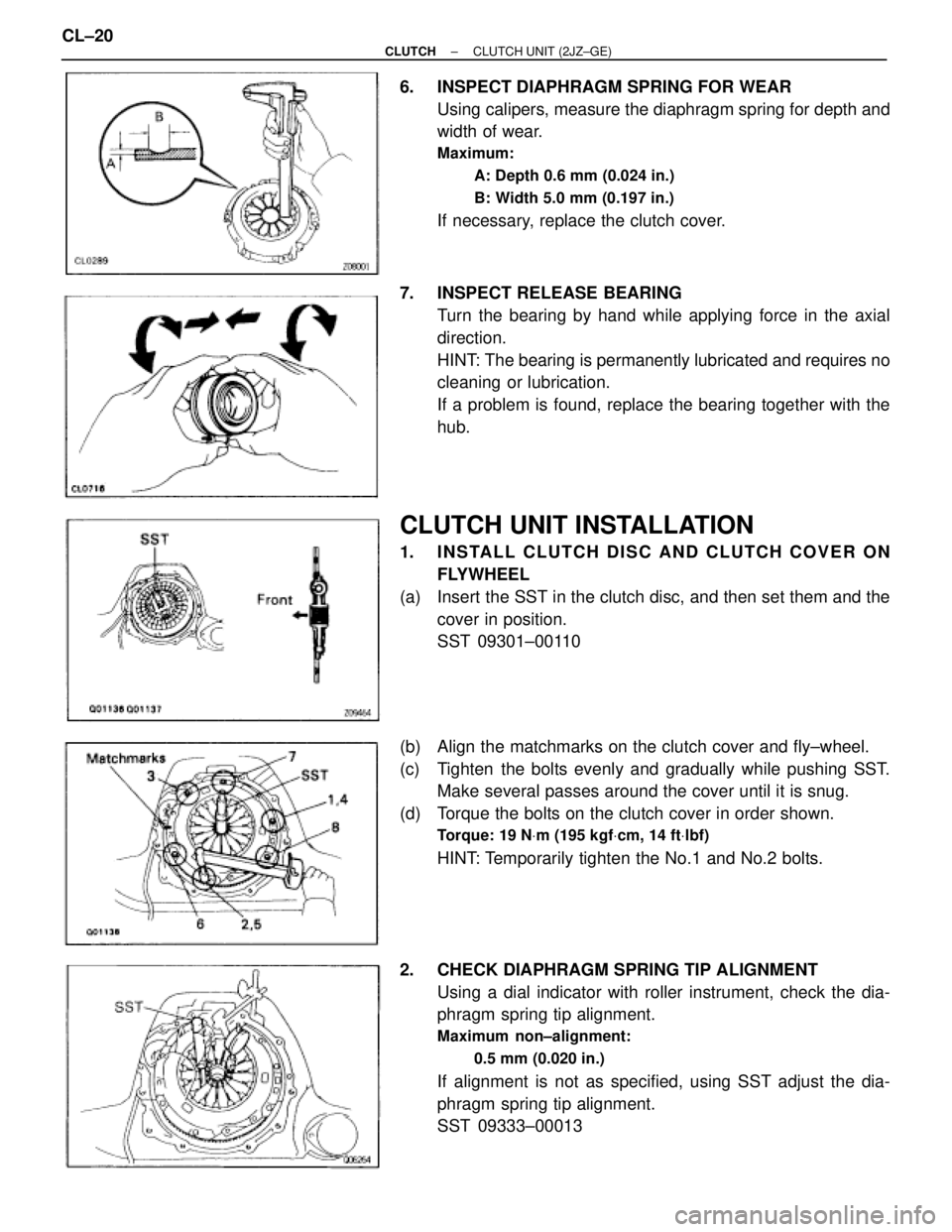
6. INSPECT DIAPHRAGM SPRING FOR WEAR
Using calipers, measure the diaphragm spring for depth and
width of wear.
Maximum:
A: Depth 0.6 mm (0.024 in.)
B: Width 5.0 mm (0.197 in.)
If necessary, replace the clutch cover.
7. INSPECT RELEASE BEARING
Turn the bearing by hand while applying force in the axial
direction.
HINT: The bearing is permanently lubricated and requires no
cleaning or lubrication.
If a problem is found, replace the bearing together with the
hub.
CLUTCH UNIT INSTALLATION
1. INSTALL CLUTCH DISC AND CLUTCH COVER ON
FLYWHEEL
(a) Insert the SST in the clutch disc, and then set them and the
cover in position.
SST 09301±00110
(b) Align the matchmarks on the clutch cover and fly±wheel.
(c) Tighten the bolts evenly and gradually while pushing SST.
Make several passes around the cover until it is snug.
(d) Torque the bolts on the clutch cover in order shown.
Torque: 19 NVm (195 kgfVcm, 14 ftVlbf)
HINT: Temporarily tighten the No.1 and No.2 bolts.
2. CHECK DIAPHRAGM SPRING TIP ALIGNMENT
Using a dial indicator with roller instrument, check the dia-
phragm spring tip alignment.
Maximum non±alignment:
0.5 mm (0.020 in.)
If alignment is not as specified, using SST adjust the dia-
phragm spring tip alignment.
SST 09333±00013 CL±20
± CLUTCHCLUTCH UNIT (2JZ±GE)